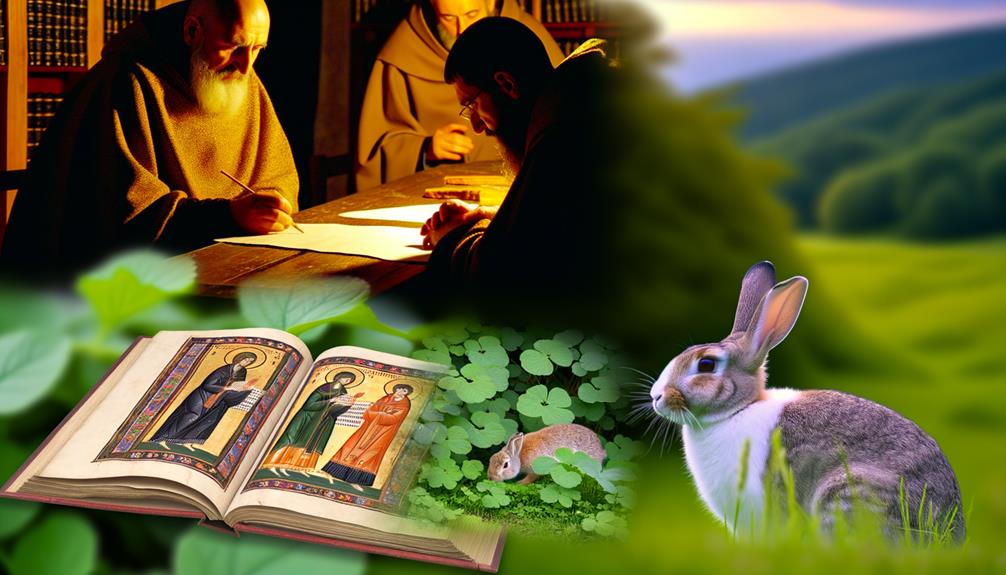Rabbit Meaning in the Bible: Cleanliness and Caution
The rabbit in the Bible primarily appears within the dietary laws, particularly in Leviticus 11:6, where it is classified as unclean due to its hoof structure. This classification underscores themes of ritual purity and obedience among the Israelites, emphasizing the need for holiness in maintaining divine commandments.
Symbolically, rabbits also evoke notions of humility, fertility, and spiritual introspection, reflecting deeper theological concepts of divine order and moral conduct. Ancient perspectives on rabbits consequently offer rich layers for understanding purity laws, cultural identity, and ethical behaviors aligned with spiritual principles.
Further exploration reveals more intricate interpretations and cultural significance.

Key Takeaways
- Rabbits are classified as unclean animals in Levitical dietary laws due to not having divided hooves.
- Symbolically, rabbits represent fertility, abundance, and rapid reproduction, connecting to themes of life and renewal.
- Their burrowing behavior and timidity symbolize humility, retreat from distractions, and reliance on divine protection.
- Rabbits embody spiritual impurity and emphasize the importance of maintaining ritual cleanliness for worship.
Rabbits in Biblical Scripture

Examining the presence of rabbits within Biblical scripture reveals contextual insights into their symbolic and cultural significance in ancient Judeo-Christian traditions.
The infrequent mentions of rabbits, or ‘hares,’ primarily occur within discussions of ceremonial and dietary laws, reflecting broader socio-religious norms. Although not a central figure in Biblical narratives, rabbits are often situated within lists of animals, contributing to the understanding of purity and holiness.
Their inclusion elucidates the ancient communities’ perspectives on creation, divine order, and ecological awareness. Theological interpretations suggest that references to rabbits underscore themes of obedience, discernment, and adherence to divine commandments.
Rabbits in Leviticus

In the Book of Leviticus, rabbits are explicitly mentioned in the context of dietary laws that delineate clean and unclean animals.
Leviticus 11:6 states, ‘And the hare, because it chews the cud but does not part the hoof, is unclean to you.’ This classification underscores the significance of ritual purity within ancient Israelite culture.
The criteria for clean animals include both cud-chewing and having a divided hoof, and the rabbit’s partial adherence to these criteria renders it unfit for consumption.
This delineation reflects a broader theological framework wherein conformity to divine commandments determines purity.
Consequently, the mention of rabbits in Leviticus is a critical element in understanding the extensive system of Levitical dietary restrictions.
Symbolic Interpretations

Beyond their dietary classification in Leviticus, rabbits also possess rich symbolic meanings within biblical theology.
Rabbits are often associated with qualities of fertility and abundance, a symbolism that stems from their rapid reproductive rate. This fecundity can be interpreted metaphorically to represent spiritual growth and divine providence, embodying the potential for new beginnings and the nurturing aspects of God’s creation.
Additionally, the rabbit’s burrowing behavior has been seen to symbolize humility and a retreat from worldly distractions, paralleling the biblical call for introspection and seeking refuge in God.
Though not as prominently featured as other animals, the rabbit’s subtle symbolism enriches the theological tapestry, offering layers of meaning for those who seek to explore deeper into scriptural interpretations.
Cultural Significance

The rabbit’s cultural significance within biblical contexts extends beyond its scriptural mentions, illuminating its role in various religious and historical traditions.
Historically, rabbits have symbolized fertility and renewal, owing to their prolific breeding. These attributes have often been allegorically linked to themes of life and resurrection in theological discourse.
Additionally, early Christian art and literature sometimes utilized the rabbit as an emblem of innocence and purity, reflecting broader cultural symbolism.
Within Jewish tradition, the rabbit’s characteristics were scrutinized to interpret dietary laws, highlighting its distinct place in cultural practices.
Consequently, the rabbit serves as a multifaceted symbol, intertwining natural observations with deeper religious meanings, enriching the biblical narrative through its layered significance.
Rabbits as Unclean Animals

In the context of biblical dietary laws, rabbits are classified as unclean animals, as outlined in Leviticus 11:6 and Deuteronomy 14:7.
This designation holds significant theological implications, symbolizing broader notions of purity and impurity within ancient Israelite culture.
Understanding the cultural context in which these laws were established provides insight into the symbolic and practical dimensions of uncleanness in biblical texts.
Biblical Dietary Laws
Under the Levitical laws outlined in the Old Scriptures, rabbits are classified as unclean animals, specifically mentioned in Leviticus 11:6 and Deuteronomy 14:7.
These texts delineate the criteria for clean and unclean animals, central to the dietary regulations for the Israelites.
Rabbits, despite chewing the cud, lack cloven hooves, thereby failing to meet the biblical standards for clean animals.
This classification underscores a divinely ordained dietary distinction, reflecting broader theological themes of holiness and separateness.
The adherence to these dietary laws not only served as a means of physical purity but also symbolized spiritual obedience and covenantal fidelity.
Understanding these regulations provides deeper insights into the religious and cultural practices of ancient Israel.
Symbolism of Uncleanness
Rabbits, designated as unclean animals within the Levitical framework, embody a broader spiritual symbolism of impurity and separation from divine holiness. The identification of rabbits as unclean is rooted in the theological and ritualistic mandates outlined in Leviticus 11:6, which serves to categorize animals based on dietary regulations.
This classification reflects several theological principles:
- Divine Holiness: The separation underscores the sanctity of God’s holiness, which must not be compromised by impurity.
- Covenantal Identity: Adherence to these laws demarcates the Israelites as a distinct, holy community.
- Moral Instruction: The laws serve as a metaphor for moral and ethical purity.
- Ritual Purity: Observing dietary restrictions maintains ritual cleanliness essential for worship.
This underscores the complex interplay between physical and spiritual purity in biblical theology.
Cultural Context Explained
The cultural context of ancient Israel greatly shaped the perception of rabbits as unclean animals, intertwining religious, social, and dietary norms to reinforce communal identity and spiritual discipline.
Levitical laws, as delineated in Leviticus 11:6, classified the rabbit among creatures that chew the cud but do not have split hooves, rendering it unclean. This classification served not merely a dietary purpose but also functioned as a theological boundary marker, distinguishing Israelites from surrounding nations.
Allegorical References

In biblical allegory, the rabbit often symbolizes timidity and vulnerability, reflecting broader themes of innocence and divine protection. This symbolism is deeply embedded in theological interpretations, offering insights into the narrative framework of scripture.
Timidity: Rabbits are naturally timid creatures, symbolizing human frailty and the need for divine guidance.
Vulnerability: The rabbit’s defenseless nature represents humanity’s exposure to sin and the necessity for divine intervention.
Innocence: Rabbits, often seen as harmless, embody purity and the untainted nature of the soul.
Divine Protection: The reliance of rabbits on their environment parallels the believer’s dependence on God for safety and sustenance.
These allegorical elements articulate the nuanced relationship between human frailty and divine benevolence within biblical texts.
Rabbits in Jewish Tradition
While allegorical interpretations of rabbits in biblical texts offer rich theological insights, their role in Jewish tradition provides a distinctive cultural and religious context.
Rabbits, or hares, are mentioned in Leviticus 11:6 and Deuteronomy 14:7, where they are deemed ritually unclean due to their cud-chewing but non-cloven-hoofed nature. This classification underscores the Jewish emphasis on dietary laws, which serve to delineate sacred and profane domains.
Additionally, the Talmudic literature occasionally references hares in discussing ritual purity and ethical behavior, symbolizing caution and vigilance.
Consequently, in Jewish tradition, rabbits are emblematic of broader themes of holiness, boundaries, and moral introspection, reflecting the intricate web of legal and spiritual principles that govern daily life.
Early Christian Views

Early Christian interpretations of rabbits, though less prominent than in Jewish tradition, reveal nuanced theological symbolism related to purity, resurrection, and vigilance.
Rabbits were considered emblematic of several virtues and spiritual concepts:
- Purity: Their association with cleanliness, given their meticulous grooming habits.
- Resurrection: Rabbits’ prolific breeding was seen as a symbol of new life, paralleling Christ’s resurrection.
- Vigilance: Known for their alertness and quick movements, rabbits represented the vigilance required of Christians in their spiritual journey.
- Humility: Their small stature and quiet demeanor were taken as models of humility and meekness in Christian conduct.
These interpretations underscore the depth and diversity in the symbolic representation of rabbits within early Christian thought.
Modern Interpretations

In contemporary theological discourse, the symbolism of rabbits has evolved, intersecting with modern faith practices and popular culture.
Rabbits are often imbued with meanings that reflect themes of rebirth and renewal, resonating with spiritual lessons pertinent to today’s believers.
This section will examine how these interpretations manifest in both religious contexts and broader societal narratives.
Symbolism in Contemporary Faith
Modern interpretations of the rabbit in contemporary faith often emphasize its symbolic association with themes of renewal, fertility, and spiritual rebirth. These interpretations are not just limited to religious texts but are also reflected in theological discussions and spiritual practices. The rabbit’s rapid reproductive cycle and emergence from burrows are symbolic metaphors in various faith traditions.
Specifically, in contemporary faith, the rabbit can be seen as representing:
- Renewal: Signifying new beginnings and fresh starts.
- Fertility: Embodying prolific growth and abundance.
- Innocence: Often linked with purity and the uncorrupted.
- Resurrection: Echoing themes of life emerging from darkness.
Such interpretations enrich modern spiritual narratives by connecting ancient symbolism with current theological thought.
Rabbits in Popular Culture
A myriad of modern representations of rabbits in popular culture underscores their enduring symbolic significance across various media and narratives.
Literature, film, and art recurrently depict rabbits, often evoking themes of innocence, fertility, and curiosity. Importantly, Lewis Carroll’s ‘Alice’s Adventures in Wonderland’ introduces the White Rabbit as a harbinger of transformative journeys, while Beatrix Potter’s tales of Peter Rabbit emphasize themes of family and caution.
Cinematically, rabbits in animated films, such as ‘Zootopia,’ continue to personify virtues like bravery and resilience. These portrayals, while secular, echo theological interpretations, illustrating moral and existential dimensions.
Such modern interpretations invite contemplation on the broader cultural and spiritual resonance of rabbit symbolism, extending beyond traditional religious contexts.
Spiritual Lessons Today
Examining contemporary spiritual lessons derived from rabbit symbolism necessitates an exploration of how these interpretations align with and diverge from traditional theological perspectives.
Rabbits, often seen as symbols of fertility and new beginnings, offer rich spiritual insights today. Modern interpretations can be summarized in several key aspects:
- Renewal and Rebirth: Rabbits symbolize new life, paralleling the Christian concept of spiritual rebirth.
- Vigilance and Awareness: Their alertness encourages believers to remain spiritually vigilant.
- Humility and Gentleness: Rabbits’ meek nature reflects biblical virtues of humility and gentleness.
- Provision and Abundance: Their rapid reproduction serves as a metaphor for divine provision and blessings.
These interpretations provide a nuanced understanding, connecting ancient theological principles with contemporary spiritual practices.
Rabbits in Art and Literature

Throughout history, rabbits have held diverse symbolic meanings in art and literature, often reflecting cultural, religious, and moral themes.
In Christian iconography, rabbits are sometimes depicted as symbols of resurrection and purity, mirroring their associations with fertility and rebirth.
Medieval manuscripts frequently feature rabbits in the margins, sometimes in scenes of subversive humor, juxtaposing innocence with mischief.
Literature, too, offers varied portrayals: from Lewis Carroll’s White Rabbit, embodying curiosity and the passage of time, to Beatrix Potter’s Peter Rabbit, symbolizing youthful defiance and the consequences of disobedience.
These depictions reveal the rabbit’s multifaceted role in human storytelling, where it serves as a vessel for deeper theological and ethical reflections, bridging the secular and the sacred.
Conclusion
In sum, the rabbit’s journey through biblical texts and interpretations reveals a creature both maligned and mystified.
Levitical decrees categorize it as unclean, while symbolic exegeses imbue it with layered meanings.
Jewish tradition and early Christian views further complicate its theological standing.
Modern interpretations continue to grapple with these ancient perceptions, often with a wink at their own erudition.
Consequently, the rabbit remains less a simple animal and more a perennial subject of theological and cultural discourse.






